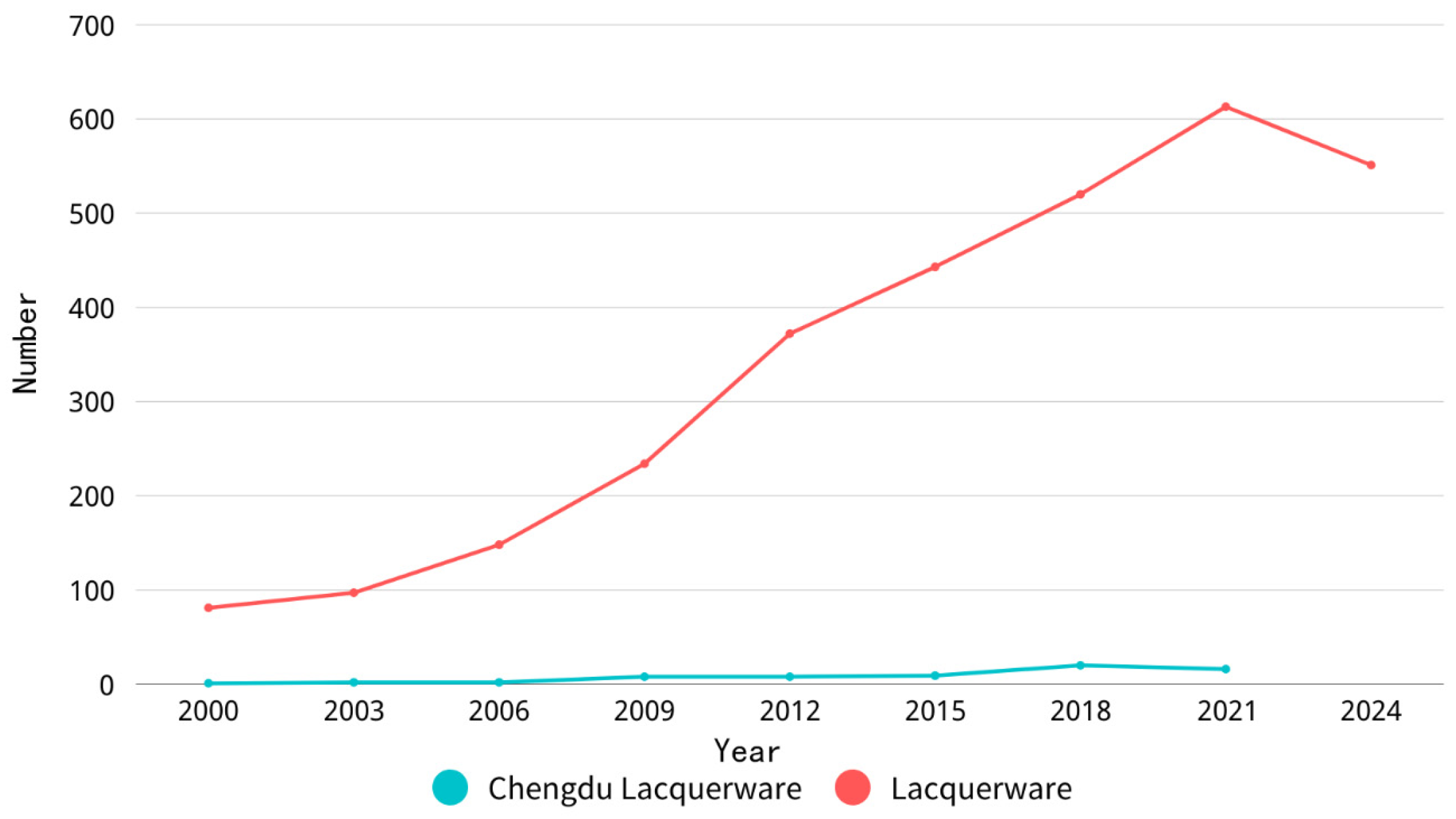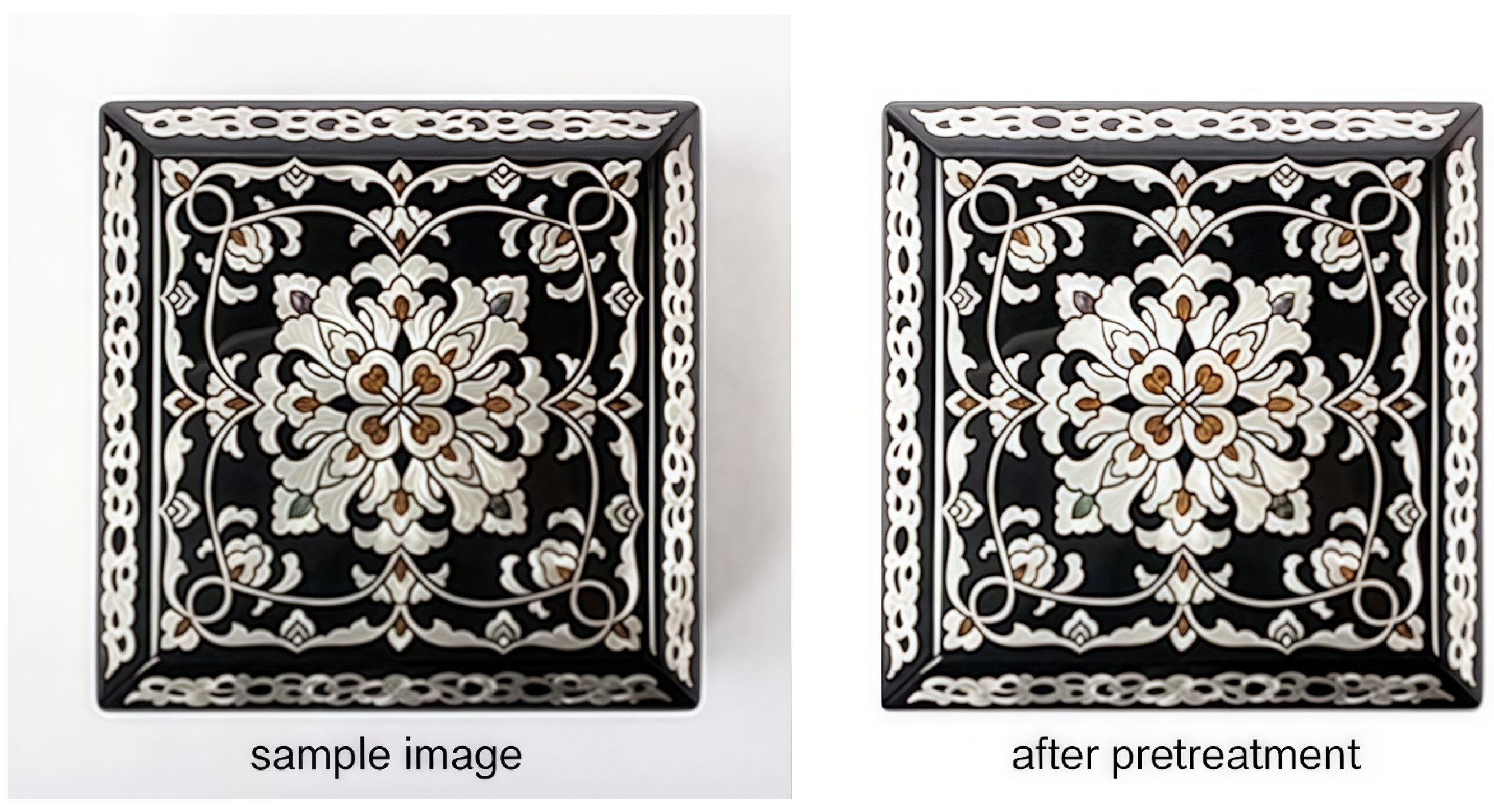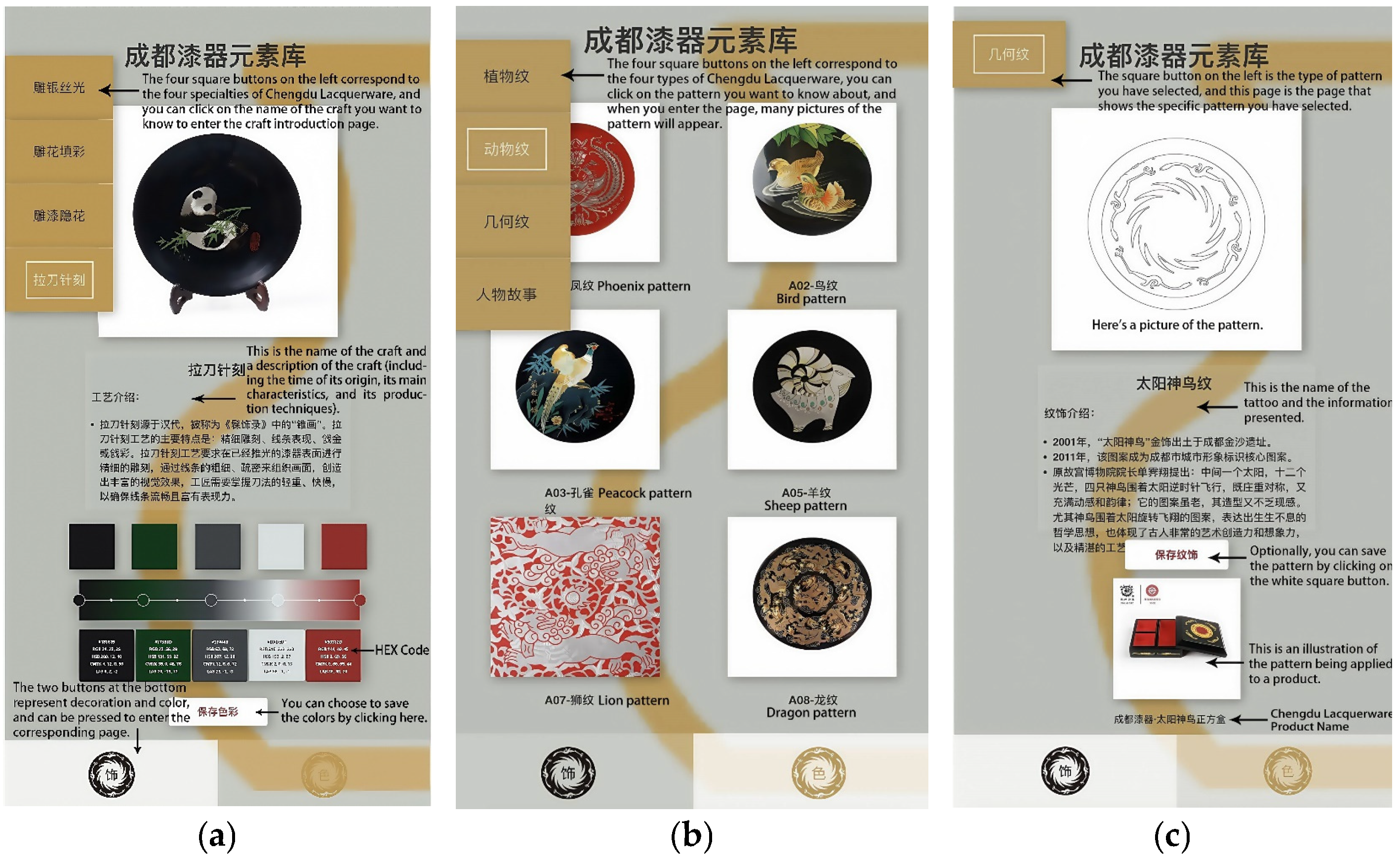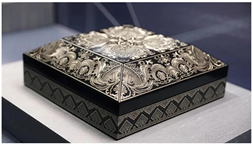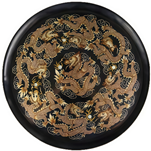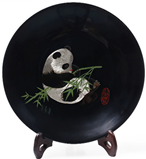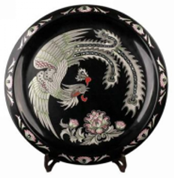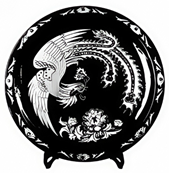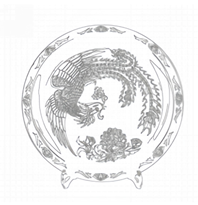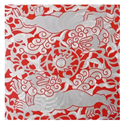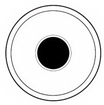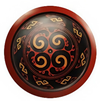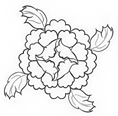1. Introduction
In 1987, the World Commission on Environment and Development (WCED) introduced the concept of sustainable development [
1]. Transforming our world, the 2030 Agenda for Sustainable Development, adopted by the United Nations General Assembly in 2015, clearly states “We recognize natural and cultural diversity and recognize that all cultures and civilizations contribute to sustainable development and are crucial contributors to sustainable development” [
2]. Culture is essential for the sustainable development of modern society. In 2003, UNESCO sponsored the Convention for the Safeguarding of the Intangible Cultural Heritage, and the term “intangible cultural heritage” (hereinafter referred to as ICH) was officially introduced. Chengdu lacquerware, as a national intangible cultural heritage, has profound historical and cultural heritage importance and unique artistic value. However, with the rapid development of modern industrialization and the strong impact of globalization, this ancient and precious craft faces a series of severe challenges. Digitalization presents a viable pathway for the sustainable development of Chengdu lacquerware. By leveraging digital techniques, we can systematically record, preserve, and disseminate its artistic craftsmanship and cultural connotations, transcend temporal and spatial constraints, and enable broader accessibility and appreciation of this traditional treasure [
3]. Digitalization can also help preserve the innovative design and production of Chengdu lacquerware to better adapt to the needs of the modern market and open a new chapter on the integration and symbiosis of traditional intangible cultural heritage and modern digital technology. Chengdu lacquerware employs four signature techniques: carved silver mercer, carved lacquer hidden flower, carved filling, and broach needle carving. As shown in
Table 1, these four techniques highlight the unique artistic value of Chengdu lacquerware. These techniques involve layering lacquer, metal inlay, and precision carving over months or years, creating its iconic layered textures and chromatic depth. Their technical complexity necessitates systematic digital documentation.
1.1. Research Status of Lacquerware in Chengdu
As a treasure of traditional Chinese craft, Chengdu lacquerware has a long history and unique artistic value. It is an indispensable part of the development process of Chinese lacquerware, not only comprising the evolution of its own craftsmanship and styles but also offering a vivid portrayal of the continuous innovation of Chinese lacquerware craftsmanship and the continuous enrichment of cultural connotations. In the Qin and Han dynasties, Chengdu lacquerware dominated the field of lacquerware in China by virtue of its exquisite craftsmanship and unique style, and its influence spread overseas, exerting a profound impact on the development of lacquerware technology worldwide. At present, the in-depth research on the inheritance and protection of Chinese lacquerware has introduced new opportunities and vitality to the inheritance and innovation of Chengdu lacquerware.
We utilized ProQuest and CNKI databases, searching with the keywords “lacquerware” and “Chengdu lacquerware” to analyze publication trends. This study provides insights into the research status of Chengdu lacquerware from a macro perspective and scientifically forecasts its future development trend to provide solid data support and a theoretical basis for the inheritance and development of Chengdu lacquerware.
According to the search results of the ProQuest database, there were 226 articles with “lacquerware” as the keyword published in the past ten years but only 18 articles with “Chengdu lacquerware” as the keyword. These data reflect the degree of academic attention paid to lacquerware research and its regional differences. As shown in
Figure 1, the number of lacquerware-related studies has fluctuated from 2015 to 2024. The relatively low number of documents between 2015 and 2017 may reflect the limited attention paid to lacquerware research at that time. However, since 2018, the number of documents has gradually increased, particularly between 2020 and 2022. This trend may be related to the increased awareness of cultural heritage preservation and the global trend of reviving traditional craft. Although the number of studies decreased in 2023 and 2024, it still remained high, indicating that lacquerware research maintains a certain continuity in the academic community. In contrast, the number of articles with “Chengdu lacquerware” as the keyword is small, and the growth trend is not obvious. This may indicate that Chengdu lacquerware, as a specific regional craft, is a niche field of research. Nevertheless, as an important part of Chinese lacquerware craftsmanship, this unique craft of Chengdu and its cultural value is worthy of further research.
As shown in
Figure 2, after searching the relevant literature using “lacquerware” and “Chengdu lacquerware” as the keywords in the CNKI database, we found that from 2000 to 2024, there were 246 documents containing “Chengdu lacquerware” in the keywords, which was less than 3% of the total studies retrieved with “lacquerware” as the keyword. The number of studies on Chengdu lacquerware appears to be growing slowly. Between 2000 and 2012, the number of studies on lacquerware in Chengdu was small, and it increased after 2012 but was still at a low level overall. Research on the types of lacquerware mainly focuses on Yangzhou, Chu, and Pingyao lacquerware. After analyzing the literature, we found that research on Chengdu lacquerware mainly focuses on the following three aspects: (1) the inheritance, protection, and innovation of Chengdu lacquerware technology; (2) the archeology, history, and culture of Chengdu lacquerware; (3) the comparative study of Chengdu lacquerware and lacquerware from other regions [
4].
At present, the development of Chengdu lacquerware is facing a multifaceted dilemma, from the perspective of process inheritance. Chengdu lacquerware production processes are numerous. The “red” technique must be coated with dozens of layers of vermilion lacquer on the tire type of the utensils and then carved out of the relief pattern after drying. This process takes as little as a few months or as long as half a year or two or three years to complete. The production cycle is long, the cost is high, and it is difficult to achieve large-scale industrial production. In addition, transmission of the craft is also relatively limited. Chengdu lacquerware craft is mostly passed on orally from master to apprentice, which is inefficient and limited in scope and cannot satisfy the demand for craft inheritance in modern society. Lacquerware craftsmanship also requires a long period of study and practice before it can be mastered, and the working environment can be relatively difficult and the income unstable, leading to a shortage of inheritors. While existing studies have broadly addressed Chengdu lacquerware’s historical, technical, and comparative dimensions, there is a notable scarcity of critical engagement with digital preservation and innovation strategies specific to this craft. Prior research predominantly relies on generic frameworks for intangible cultural heritage digitization, with limited application to the unique technical complexities of Chengdu lacquerware. Given this nascent state of research, our study adopts a pioneering role by developing a digital methodology for its systematic documentation and contemporary adaptation. To address the above challenges, a combination of Chengdu lacquerware and digital technology is imperative.
1.2. Research Status of the Digital Empowerment of Intangible Cultural Heritage
In August 2021 and May 2022, the General Office of the Central Committee of the Communist Party of China and the General Office of the State Council jointly issued Opinions on Promoting the Implementation of the National Cultural Digitization Strategy and Opinions on Further Strengthening the Protection of Intangible Cultural Heritage. Digitalization mainly refers to digital technology, which is simply a technology that can serve various fields by using “0” and “1” binary encoded digits and relying on the Internet and computer technology to express information [
5]. Digital technology has been fully applied to all aspects of human production and life, promoting the rapid development and transformation of society [
6]. Chang Guoyi et al. proposed that the digital presentation of intangible cultural heritage genes not only represents the inheritance of past traditions, but is also the inevitable “evolution” of traditions in the new era [
7]. Digital technologies such as 3D scanning, photogrammetry, and high-resolution imaging have revolutionized the documentation and archiving of ICH. These tools enable the creation of precise digital replicas of cultural artifacts, traditional performances, and practices. For example, 3D scanning has been used to capture the intricate details of traditional crafts, allowing their preservation in digital formats that can be accessed and studied indefinitely [
8]. Digital archives, such as the UNESCO Intangible Cultural Heritage website, serve as repositories for these digital records, making them accessible to researchers and the public [
9]. VR and AR technologies have also been widely adopted to create immersive experiences that bring ICH to life. VR allows users to participate in traditional ceremonies, festivals, and rituals, providing an interactive way to experience cultural practices that may be inaccessible geographically or temporally. AR overlays digital information on the physical world, enhancing the experience of visiting cultural sites or interacting with artifacts. For example, AR applications have been developed to provide contextual information about traditional dances or music performances when users point their devices at specific locations or objects [
10]. Using Miao batik as an example, Zong Cheng et al. introduced the use of digital techniques to highlight and preserve batik craftsmanship, employing artistic design techniques to categorize this craftsmanship into reasonable steps and transforming such steps into visual graphic image language. This ensured the logic and integrity of the use of visual language to support the sustainable development of intangible cultural heritage, effectively combining digital technology and intangible cultural heritage traditional handicrafts [
11]. Taking Mianzhu New Year paintings as an example, Hu Guankai et al. elaborated on the development strategy for intangible cultural heritage inheritance and innovation in the context of digitalization. They used digital technology to establish a material library of New Year paintings and applied digital elements to the development of cultural and creative products, which provided a reference for this study [
12].
Digital technology has become a vital driving force in the protection and inheritance of intangible cultural heritage, which not only enables the innovative development of intangible cultural heritage but also opens up new ideas for the protection, dissemination, and inheritance of traditional culture. Digital technology offers new vitality and significance to the current social environment, serving to support the sustainable development of traditional intangible cultural heritage [
13]. To fill the gaps identified in the existing research, this study employs digital techniques to analyze Chengdu lacquerware’s colors and patterns.
2. Materials and Methods
In a study of Chengdu lacquerware, a variety of digital technologies were used to explore its artistic value. First, the colors of Chengdu lacquerware were digitally extracted using the K-means algorithm, and the expression ability and research accuracy of the color characteristics were significantly improved through visualization technology. Through digital color extraction, the unique colors of Chengdu lacquerware were closely matched to the selection of the paint base, the interaction of multiple layers of lacquer, and the application of process techniques, which together form the unique color style of Chengdu lacquerware. In addition, binarization and pattern edge detection technology were used to digitally extract the ornamentation patterns of Chengdu lacquerware, which was crucial in revealing the details of the ornamentation. This technology successfully identified the most representative characteristics through in-depth analysis and reconstruction of ornamental elements, which further strengthened the iconic features of Chengdu lacquerware as a traditional aesthetics.
2.1. Image Preprocessing
A comprehensive collection of images was assembled to establish an image database, as a larger sample size enhances the accuracy of color extraction results. In total, 307 images of Chengdu lacquerware were acquired through on-site photography, online repositories, and digitizing the pictorial literature. Image selection followed rigorous criteria to ensure methodological validity: (1) Clarity: only high-resolution images with visible craftsmanship details were retained. (2) Authenticity: images were cross-verified against historical archives and Chengdu lacquerware catalogs to confirm regional specificity, excluding non-Chengdu pieces. (3) Representativeness: samples covered all four key techniques. (4) Color fidelity: images with significant discoloration or artificial lighting distortions were excluded. This systematic approach ensured the dataset’s reliability for digital analysis while preserving Chengdu lacquerware’s unique stylistic identity. Owing to the challenges of light and color aberrations in the collected pictures, preprocessing was required. First, the images were sorted and filtered; images that were blurry and had large color differences and weird angles were removed. Then, the watermark and background were removed, and the image size parameters were unified to reduce the impact on the subsequent color extraction results. As shown in
Figure 3, standard white RGB values (255, 255, 255) were used as a reference to correct the colors in Adobe Photoshop CC2019.
Chengdu lacquerware is famous for its unique craftsmanship and style. Its painting process is based on an ancient foundation, and along with the traditional lacquer process, Chengdu’s lacquer craftsmen also created the carved silver mercer, carved lacquer hidden flower, carved filling, and broach needle carving processes. These processes represent the iconic style and artistic value of Chengdu lacquerware [
14]. To ensure the accuracy and rigor of the research and to avoid confusion with lacquer art from other regions, the subsequent color extraction was based on the lacquerware found in these four characteristic crafts.
After the image preprocessing was completed, the pictures were classified and sorted according to four characteristic processes, totaling 101 carved silver silk, 96 carved lacquer hidden flowers, 52 carved and filled colors, and 31 broach carvings. This classification facilitated subsequent color extraction research and supported a more systematic and in-depth analysis of the color characteristics of Chengdu lacquerware technology.
2.2. Color Extraction
Although including all the colors of Chengdu lacquerware can fully show its overall color application, owing to the large number, representing the entire color palette of Chengdu lacquerware was difficult. Therefore, it was necessary to conduct secondary cluster extraction. The specific approach first extracted the color from the lacquerware pictures of a particular process, integrated all the color blocks obtained via single clustering in accordance with the original color and proportion in a single picture to form the color card of the lacquerware process, and then saved the image of this fusion of colors as the sample image for secondary clustering. We conducted the secondary clustering using the sample image to determine the characteristic color representing the particular process under study. The clustering parameters were K = 8 for single clustering, K = 16 for secondary clustering, and a specified threshold of tol = 0.001. The image eligibility requirements were as follows: (1) ≥300 dpi resolution; (2) ≥80% visible surface area; (3) confirmed Chengdu origin via museum/artist verification.
2.2.1. Single Clustering
The number of main colors extracted according to the RGB brightness mode was set to six, and the characteristic colors were selected as the clustering center at equal distances and angles along the hue ring; five characteristic colors were extracted from each picture. In the extraction result, the size of the color block represented the proportion of colors in the object, and the proportion of each color was obtained by calculating the pixel area of the color block. After the extraction was completed, the basic information of the main colors was classified and analyzed, and to accurately calculate the proportion, the pixel area of each color block, the proportion of the corresponding colors in the lacquerware, the RGB value, and the Lab value were recorded.
According to the data in
Table 2, the main color was black, accounting for 68.6%, which set the tone for an elegant style. Black/gray accounted for 13.3%, which was used for detailed shading or transition to increase the sense of hierarchy and coordination. With red, blue, and yellow embellishments accounting for 8.15%, 7.8%, and 2.2%, respectively, the contrast of cold and warm colors gave the lacquerware a lively and bright visual effect, achieving the unity of beauty and practicality.
2.2.2. Secondary Clustering
After completing the single-color clustering of Chengdu lacquerware, it was necessary to record the information of each color in detail and then save the extraction results of the different processes to the same canvas. All extracted colors on the canvas were used as input samples for the second color clustering to extract the most representative colors. As shown in
Figure 4, using images of the carved and filling process as an example, after the two clustering processes, the five characteristic colors of the process were obtained, which provided the basis for an in-depth analysis of the color art of Chengdu lacquerware.
2.2.3. Chengdu Lacquerware Characteristic Color Extraction
Following the above color extraction process, we extracted the characteristic colors of the Chengdu lacquerware. After completing the extraction process, quantitative data such as the percentage of each of the five characteristic colors, RGB values, and spectral chromaticity values (Lab) were recorded in detail in the document. Through the collation and analysis of these data, the differences in the uses of color in different crafts were further explored, and the meanings behind these differences were investigated for a comprehensive understanding of the color art of Chengdu lacquerware crafts.
Characteristic Color Analysis of the Carved Silver Mercer Process
As seen in
Table 3, black and silver-gray were the main characteristic colors of the carved silver mercerizing process, accounting for more than two-thirds of the total. Black accounted for 42.8% and was used as the base color of the lacquerware; silver-gray accounted for 21.6% and was the main decorative color, adding layers to the contrast with the paint base; and neutral gray-green accounted for 13%, balancing the colors of the picture. Although the proportion of red was small, there were two shades for a total of 11.3%, and it was often embellished with metal plate engraving patterns to add a bright and lively feeling. The overall colors of the carved silver-mercerized process were exquisite, and the fine handicraft craftsmanship complemented them.
Analysis of the Characteristic Colors of the Carved Lacquer Hidden Flower Process
The characteristic color card of the carved lacquer hidden flower process contained mainly low-saturation colors, which reflected the introverted and subtle characteristics of a calm and solemn temperament and presented a constant beauty in different light environments. From the analysis results shown in
Table 4, it can be seen that black and red, which accounted for 54%, were the most widely used and comprised the main background colors used. Dark green accounted for 7.5% and was used less as a base color. Sauce red and dark yellow accounted for 5.2% and 4.9%, respectively, and were used for decorative embellishment, of which the dark yellow was gold powder painted on the dark lacquer surface. The gold changes brightness with the light, creating a luxurious and mysterious decorative effect, in line with the fine craftsmanship and understated aesthetic.
Analysis of the Characteristic Colors of the Carved Filling Process
The characteristic color cards of the carving and filling processes showed lively and bright colors. As seen in
Table 5, black accounted for 46.3% of the main colors, which was in line with the production habits of lacquerware, and it balanced the light and dark colors and highlighted the pattern decorations. Red accounted for 34.7%, making it the second-most popular color, and it enlivened the lacquerware and added visual impact. Green, gold, and yellow accounted for 9.6%, 6.6%, and 2.8%, respectively, reflecting the diversity of colors used in the filling process and the rich decorative effects. The contrast between these colors and the dark primer enhances the three-dimensional effect, and the colors become more vivid, and their luster softens over time, which is a unique characteristic of the process.
Analysis of the Characteristic Colors of the Broach Needle Engraving Process
The characteristic color card of the broach needle engraving process clearly showed the simplicity of its color application. The color pattern differed greatly from the carving and filling process, which mainly relied on fine line depictions to present complex patterns and scenes rather than rich color variations. As seen in
Table 6, the proportion of black primers was as high as 65.9%, which was similar to the canvas of a traditional painting. Line changes are at the heart of the process, in which artisans use special knives to carve lines on a dark primer. Through changes in line thickness, density, and direction, they vividly depict human stories and natural landscapes, creating realistic lifelike ornamentation.
Although the amount of silver wire used was only 8.8%, this proportion is very important in this work. Its unique gloss and light-absorbing properties, set off by a black primer, highlight a clear sense of layering, and because it is sensitive to ambient light, silver has different effects under different light conditions, adding dynamic beauty. Affected by the interaction between the silver filament and primer, the dark gray colors accounted for 9.4%, enriching the visual effect. Green and red were accent colors; although they did not account for a high proportion, they effectively enhanced the color level of the picture and the expressiveness of lacquer works. Overall, the process uses simple colors and fine lines, which fully demonstrates the superb craftsmanship and aesthetics of Chengdu lacquerware craftsmen.
2.3. Ornamental Extraction
As a jewel of the traditional culture of China, Chinese patterns carry profound historical heritage and rich cultural connotations and exude unique charm in art and life after thousands of years of development and evolution. Patterns are the most important phenotypes of a craft’s cultural genes, and almost all traditional crafts, regardless of whether they are ancient or modern and of the Han or ethnic minorities, use patterns as a means of identification and decoration [
15]. From the simple totem worship of primitive society to the social and religious significance given to slave society, extending to the more brilliant expression of feudal society, patterns carry the cultural connotation of their period and are a reflection of the cultural characteristics of different regions and ethnic groups [
16].
2.3.1. Binarization Processing and Image Edge Detection
Image binarization is the transformation of digital images into a matrix of binary black and white pixels, separating certain areas from the background and laying the foundation for the edge extraction and image processing of subsequent images [
17]. The grayscale value of the pixels in the image is usually set to 0 or 255, resulting in a noticeable black and white effect. The key to binarization is selecting an appropriate threshold to achieve an accurate segmentation of the target and context [
18]. Binary processing is of great value in the field of pattern research. After the digital collection of patterns, binary processing can remove the interference information caused by the erosion of time, color fading, stain obscuration, etc. The original lines and structure of the pattern are then clearly presented, which allows researchers to accurately analyze the composition of the pattern and the artistic style and cultural meaning behind it.
However, when processing such images, the traditional binarization method is prone to problems such as an inability to effectively detect character information and the generation of noise, decreasing the image quality and affecting subsequent image processing [
19]. Image edge detection is also an important technology in digital image processing, in which the image edge refers to the area where the gray value changes sharply. The basic principle of edge detection is the determination of the edge position of an image by detecting sudden changes in the gray values. Clear edge extraction facilitates the digital reproduction of ornamentation and is often used in image restoration, cultural relic restoration, computer vision, and other fields [
20].
It can be observed from
Table 7 that the combination of binarization processing and image edge detection offers obvious advantages in pattern processing. Binarization can enhance the image contrast, simplify complex pattern images, filter out redundant colors and grayscale information, retain only key foreground and background data, and reduce the amount of data and the burden of subsequent processing. Edge detection can effectively filter noise, accurately outline the pattern, make the edges clear and coherent, enhance the detailed features of the pattern, facilitate the identification and analysis of the shape and structure of the pattern, and extract the pattern elements more efficiently.
Through the above extraction and analysis of the colors of Chengdu lacquerware, it was found that the production process comprises mainly carving, utilizing fine decorations, rich details, various decorative colors, and different colors for different processes. Based on these image characteristics, the combination of binarization and edge detection is more conducive to subsequent image analysis and processing in practical applications. Therefore, the combination of the two is a more scientific means for the extraction of ornamentation. After selecting this extraction method, Chengdu lacquerware ornaments were extracted according to the process shown in
Figure 5.
2.3.2. Chengdu Lacquerware Ornament Extraction
Chengdu lacquerware is a treasure of traditional Chinese art possessing rich and varied decorations and distinctive features. The types of decorations are mainly divided into animal, plant, geometric, and a few social life themes. The animal patterns are smart and expressive, with the dragon and phoenix patterns being the most representative. The dragon pattern is majestic and noble, symbolizing power and auspiciousness; the phoenix pattern is beautiful and elegant, auspicious and beautiful, and is often used in high-grade lacquerware, highlighting its extraordinary status. The plant ornament is fresh and elegant: the peony pattern symbolizes wealth and prosperity, and the petals are stretched layer by layer, showing its gorgeousness. The lotus pattern implies purity and elegance, and the petals are smooth, indicating a serene temperament. The geometric ornamentation is simple and regular, and the echo pattern is composed of continuous whirlwind lines, implying longevity. This pattern is often found on the edges of utensils, adding a sense of rhythm to the lacquerware. The diamond-shaped pattern is arranged in an orderly manner with a strong visual impact, highlighting the beauty of order [
21].
When collecting patterns, priority was given to those with high definition and distinctive features to ensure the accuracy of subsequent identification and extraction. Because Chengdu lacquerware is made entirely by hand and the process is non-fixed and unrestrictive, affecting the identification of decorative features, the extracted ornaments must be translated to clarify and fully display the artistic characteristics.
Subsequently, the collected ornaments were classified according to animal patterns, plant patterns, geometric patterns, and social life themes, and their basic units were analyzed. The decoration areas with the most obvious incision contrast and clearest colors were cut. Finally, the Chengdu lacquerware ornament extraction dataset was compiled, which covered animal patterns, plant patterns, and geometric patterns, as presented in
Table 8,
Table 9 and
Table 10, respectively, and these three types of ornaments were used as subsequent sample materials. The ornaments with social life themes were not used as sample materials for extraction because they are scarce, and their characteristics are not significant enough and lack representativeness.
2.4. Refinement and Reconstruction of Ornamentation
Element refining refers to the extraction of useful design elements from complex pattern structures [
22]. When refining the elements, it is first necessary to examine the form, line, colors, and meaning of ornamentation. For the smooth lines of flower and bird ornaments, the simplified method can be used to remove the cumbersome details, retain the most representative outline and dynamics, and then disassemble and reorganize the details. The method of disassembly and reorganization separates the modeling elements, structural layout, and color matching of the pattern and then reassembles them. This process breaks down the original structure and creates a new structure, alternately and harmoniously matching the traditional and modern elements and finally forming a new pattern [
22].
After a systematic and in-depth study of Chengdu lacquerware decoration samples and considering factors such as frequency and artistic value, eight high-frequency patterns were selected as the basic elements of the design (
Table 11). These ornaments were mainly botanical and animal patterns, which have been extensively used over the years and are an indispensable part of the decorative language of Chengdu lacquerware. Respecting and retaining the original characteristics, modern design concepts and advanced graphic processing technology were used to extract and promote the evolution of these ornaments. The outline, lines, and proportions of the ornament were finely adjusted and optimized, and the complicated and redundant parts were removed to make the shape of the ornament more concise and smoother and the image more vivid and clear. In this way, the ancient Chengdu lacquer decorations glow with new vitality, creating a visual image that is rich in traditional cultural connotations while in line with modern aesthetic trends, opening up a new path for the contemporary inheritance and development of traditional lacquer art.
3. Results
At present, many forms of intangible cultural heritage are still passed on orally through demonstration and are at risk of extinction due to factors such as the loss of inheritors and changes in the social environment [
23]. The creation of a digital resource library facilitates comprehensive and systematic documentation of intangible cultural heritage elements. This ensures the preservation of accurate and complete information for future generations while enabling the permanent safeguarding of such heritage. Additionally, it elucidates the historical origins, developmental trajectory, and evolutionary processes of these elements, thereby highlighting cultural continuity and richness. This preservation highlights the inheritance and innovation of culture in different historical periods, allows us to understand the continuity and richness of culture, enhances the sense of cultural identity and belonging, and ensures the continuation of cultural genes [
24].
In this study, the characteristic colors of Chengdu lacquerware were extracted using the K-means algorithm, and the typical patterns of Chengdu lacquerware were extracted using binarization and pattern edge detection technology. We constructed a Chengdu lacquerware resource library that reflects the regional artistic and cultural characteristics of Chengdu. Compared to manual extraction, our method achieved a 92% color matching accuracy with 10-fold improvement, demonstrating enhanced pattern recovery.
When constructing the Chengdu Lacquerware Resource Library, two key components were included. The first was the Chengdu lacquerware color resource library, which contains the characteristic color card of Chengdu lacquerware, and the second was the Chengdu lacquerware ornament resource library, which includes representative ornamentation. These rich resources will be important sources of elements for subsequent practices. The extracted feature colors and simplified and reconstructed line drawings were saved to the interactive platform, which contains a library of Chengdu lacquer design elements. Other designers can easily view and use these resources on the platform. The extracted representative colors and simplified ornaments offer high flexibility and can be used in various fields, such as the study and creation of household items, fashion accessories, packaging design, and cultural and creative design, greatly enriching the diversity of design and broadening the scope of application.
As shown in
Figure 6, the characteristic colors display page of the Chengdu lacquerware process accurately provides specific colors values and a brief description of key techniques such as decoration, painting, and inlay. By displaying high-definition images of the corresponding lacquerware, it effectively promotes the audience’s understanding of the application of Chengdu lacquerware technology. Taking the traditional vermilion as an example, its color value is RGB (255, 0, 0), and the decoration technique is often used in Chengdu lacquerware, using natural lacquer as raw material and coating it layer by layer, so that the color is bright and has a warm texture. The ornamental element classification page is systematically organized according to the categories of plant, animal, geometric, and character story patterns. Specific ornament pages not only present the fine line drawing of the ornament but also provide an in-depth interpretation of the meaning. At the same time, the page displays an image of the lacquerware, visually presenting the initial effect of the ornament on the lacquerware. For example, under the category of geometric patterns, if a user selects the “Sun God Bird Pattern”, the page displays the smooth lines and well-layered line drawings, providing an interpretation of the meaning of the Sun God Bird Pattern while simultaneously displaying the actual Chengdu lacquerware decorated with the Sun God Bird Pattern. This offers the viewer a clear understanding of its practical application effect on the lacquerware.
Intangible cultural heritage elements are important symbols of national culture, and the display and dissemination of these unique cultural elements through the resource library provide viewers with a deeper understanding of the cultural characteristics and spiritual connotations of their own nation, enhance their sense of national pride and identity, and promote national unity and social stability [
25].
4. Discussion
In this study, the colors and decorations of Chengdu lacquerware were systematically extracted and analyzed through digital technology, and a Chengdu lacquerware resource library was constructed, providing a new path for the inheritance and innovation of this craft. The use of digital technology not only improves the efficiency of design but can also better refine and disseminate traditional aesthetics by dismantling and reconstructing decorative elements through the extraction and analysis of the colors and decorations of Chengdu lacquerware. This not only provides inspiration for modern design but also transforms the color matching heritage of Chengdu lacquerware into symbolic language and enhances the depth and cultural connotation of design.
However, in the digital empowerment process, there remain issues worthy of in-depth discussion. From a technical point of view, although K-means algorithms, binarization, and pattern edge detection technologies have played key roles in color and ornament extraction, there is still room for optimization. In color extraction, the production process for Chengdu lacquerware is complex, and the different processes, lacquer layers, and production environment differences intensify the complex and changeable characteristics of the colors. When the current algorithm is applied to special processes or colors that are affected by the environment, it may not be able to accurately restore the true appearance, resulting in deviations in the extracted color features. Chengdu lacquerware ornamentation is delicate and contains rich cultural connotations, and its extraction is susceptible to image noise interference, which affects the accuracy of edge detection, leads to the loss of some ornamental details, and complicates the full presentation of its artistic value and cultural meaning. Therefore, follow-up research is needed to continuously improve the processing capabilities of these technologies for complex images and ensure that the extracted colors and ornamental information are more accurate and complete.
Regarding practical implementation, while the Chengdu lacquerware resource library offers abundant design elements, it encounters significant challenges when integrated into modern design paradigms. Translating traditional lacquerware colors and decorations into modern household products or fashion accessories necessitates careful consideration of contemporary aesthetic principles, lifestyles, and functional demands. Simply transplanting traditional elements may lead to the product being out of touch with the modern market. In addition, in cross-field applications, ensuring that Chengdu lacquerware elements maintain their unique characteristics using different materials and processes is a challenge. For example, when applying lacquerware ornamentation to metal fashion accessories, it is necessary to employ an appropriate process to ensure the fineness and texture of the ornamentation and avoid losing the original charm due to material differences. In addition, although the sharing of resource pools can promote cultural exchanges between different regions and ethnic groups, this may also face the problem of protecting intellectual property. Therefore, protecting intellectual property rights while sharing and disseminating resources must be addressed.
Digital empowerment of the development of Chengdu lacquerware is a potential direction, but in-depth research and practice are still needed in terms of technology optimization, application transformation, and cultural inheritance and protection. Only by solving these problems can we truly realize the sustainable development of Chengdu lacquerware in the digital era and allow this traditional intangible cultural heritage culture to glow with new vitality in the new era.
5. Conclusions
This study used Chengdu lacquerware as the research object, analyzed its development status, identified the main problems currently faced by its future development, extracted the characteristic colors and decorations of Chengdu lacquerware with the help of the K-means algorithm and binarization and pattern edge detection technology, and constructed a Chengdu lacquerware resource library, an open platform to promote the exchange and interaction of intangible cultural heritage processes between different regions and ethnic groups. The aim is to promote the pluralistic integration and common development of culture and enhance the innovation and transformation of intangible cultural heritage in the new era.
The deep integration of digital technology and Chengdu lacquerware preservation and innovation has injected new vitality into Chengdu’s lacquerware-related industry. Through the resource library, designers can easily identify its characteristic elements and apply them to household products, fashion accessories, and other fields, enrich the cultural connotations of products, and enhance market competitiveness. At the same time, this integration model provides a reference model for the combination of other forms of intangible cultural heritage and digitalization and realizes the sustainable development and potential of traditional intangible cultural heritage under the wave of digitalization.
While this study advances the digital documentation of Chengdu lacquerware, there remain areas that need further in-depth exploration and refinement. Current limitations include a dataset biased toward modern pieces. Furthermore, our exclusive focus on the chromatic attributes overlooks the material textural nuances, a critical lacunae given lacquerware’s tactile primacy in heritage contexts. Future research should be devoted to a more comprehensive and systematic integration of the traditional aesthetics of Chengdu lacquerware with modern design concepts to promote its innovative inheritance and development in contemporary society.

